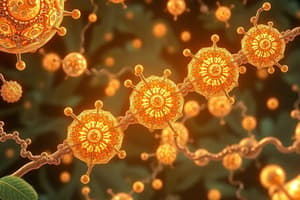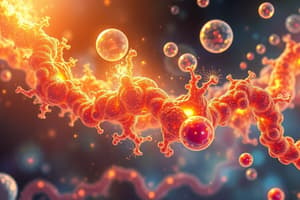Podcast
Questions and Answers
What is the primary role of enzymes in chemical reactions?
What is the primary role of enzymes in chemical reactions?
- To break covalent bonds in substrates
- To catalyze reactions without being consumed (correct)
- To increase the temperature of the reaction
- To lower the activation energy required for reactions (correct)
How do competitive inhibitors affect enzyme activity?
How do competitive inhibitors affect enzyme activity?
- They bind to a different site on the enzyme
- They increase the affinity of the enzyme for its substrate
- They stabilize the enzyme-substrate complex
- They block the active site of the enzyme (correct)
Which factors are crucial for optimizing enzyme activity?
Which factors are crucial for optimizing enzyme activity?
- Presence of coenzymes and optimal environmental conditions (correct)
- Concentration of enzymes relative to substrate (correct)
- Type of chemical reactions in the pathway
- Velocity of substrates entering the reaction
What is feedback inhibition in biochemical pathways?
What is feedback inhibition in biochemical pathways?
What distinguishes allosteric activators from normal enzyme activators?
What distinguishes allosteric activators from normal enzyme activators?
Which statement accurately describes the properties of the rate-limiting reaction in a biochemical pathway?
Which statement accurately describes the properties of the rate-limiting reaction in a biochemical pathway?
What is the significance of the second law of thermodynamics in biological systems?
What is the significance of the second law of thermodynamics in biological systems?
In what way do chloroplasts and mitochondria differ in their energy transformation processes?
In what way do chloroplasts and mitochondria differ in their energy transformation processes?
How does free energy (G) relate to the capacity to perform biological work?
How does free energy (G) relate to the capacity to perform biological work?
What type of energy exists within chemical bonds that can be transferred during chemical reactions?
What type of energy exists within chemical bonds that can be transferred during chemical reactions?
Flashcards are hidden until you start studying
Study Notes
Enzymes and Energetics
- Enzymes are biological catalysts that speed up chemical reactions by lowering activation energy (Ea)
- Enzymes lower Ea by:
- Aligning substrate functional groups for reactions (e.g., dehydration)
- Stretching substrate bonds, straining them (e.g., hydrolysis)
- Creating microenvironments with altered pH
Enzyme Affinities and Cycles
- Enzymes have specific affinities for substrates due to their shape matching the enzyme's active site
- One enzyme typically interacts with one or a few substrates
- The enzyme-substrate complex changes shape during catalysis
- Enzymes are not consumed during catalysis, allowing for repeated cycles
- Enzyme activity is influenced by the ratio of substrate concentration to available active sites
Optimization and Inhibition
- Enzyme activity is optimized by factors like:
- Cofactors (ions)
- Coenzymes (e.g., NAD+)
- Optimal temperature, pH, and salinity
- Enzyme inhibition occurs through competition (blocking the active site) or non-competition (deformation of the active site)
- Inhibition can be reversible or irreversible
Activators and Inhibitors
- Allosteric activators stabilize the active form of allosteric enzymes (4° proteins)
- Allosteric inhibitors stabilize the inactive form of allosteric enzymes
Feedback Inhibitors
- Feedback inhibition occurs when products of a pathway inhibit enzymes involved in earlier reactions
- Often happens through reversible non-competitive inhibition
Biochemical Pathways
- A biochemical pathway is a series of linked chemical reactions
- Products of one reaction become reactants for the next
- Enzymes catalyze reactions within these pathways
Mevalonate Pathway
- Cholesterol is synthesized through the mevalonate pathway
- HMG-CoA to mevalonic acid is a rate-limiting step
Rate-Limiting Reactions
- The slowest reaction in a pathway is the rate-limiting step
- Often targeted by pharmaceuticals to modify pathways (e.g., statins inhibit HMG-CoA reductase, reducing cholesterol synthesis)
Basics About Energy
- Energy is the capacity to do work
- It can change the position, composition, and temperature of matter
- Energy exists in two states:
- Potential energy: stored energy with the capacity to do work (e.g., membrane potential)
- Kinetic energy: actively doing work
- Different forms of energy exist: solar, electrical, mechanical, chemical, and heat
- Chemical energy is stored within chemical bonds and released when bonds break
Thermodynamic Laws
- Thermodynamics studies energy transfer and transformation
- First Law: Energy can be transformed and transferred but not created or destroyed
- Photosynthesis converts solar energy into chemical energy (sugars) in chloroplasts
- Cellular respiration converts chemical energy in sugars to ATP in mitochondria
- ATP powers biological work (e.g., active transport)
- No energy transformation is 100% efficient, some energy is lost as heat
Second Law
- Energy transfer during transformations increases entropy (disorder) in the universe
- Harnessing energy for biological work is required to maintain order
- Heat has limited ability to perform biological work and contributes little to maintaining order
- As "higher order" forms of energy (e.g., solar) are transformed into heat, less energy remains available for biological order (entropy increases)
Gibbs Free Energy
- Free energy (G) is the energy available to do work
- ΔG is the change in free energy (GFinal - GInitial)
- Exergonic reactions release energy (-ΔG) and are spontaneous (occur without external energy)
- Endergonic reactions require energy (+ΔG) and are not spontaneous
Cells Transforming Energy
- Photosynthesis is overall endergonic, requiring solar energy
- Cellular respiration is exergonic, releasing free energy from glucose
- Some energy from glucose is used to produce ATP, while some is lost as heat
Don't Equilibrate to Live
- Many chemical reactions are reversible and reach equilibrium (equal rates of forward and reverse reactions)
- Equilibrium is unfavorable for living organisms as ΔG = 0 (no free energy for work)
- Living organisms maintain negative ΔG to perform work, a state called metabolic steady state
Studying That Suits You
Use AI to generate personalized quizzes and flashcards to suit your learning preferences.




